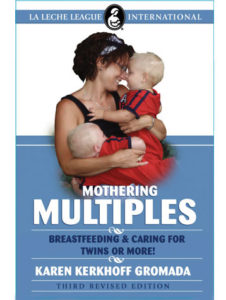 I have always wondered why women, myself included, get such odd looks and negative comments when we say we are going to breastfeed our expected twins, triplets or more. Because once a mother and her babies get the breastfeeding “down,” it’s actually easier to breastfeed. Also, each multiple and his/her mother has as much right to the breastfeeding relationship (and mother’s milk) as any infant born alone. The following are some ideas for beginning to breastfeed during the early weeks or months with multiples. (And many of these tips also work if expecting a singleton!)
I have always wondered why women, myself included, get such odd looks and negative comments when we say we are going to breastfeed our expected twins, triplets or more. Because once a mother and her babies get the breastfeeding “down,” it’s actually easier to breastfeed. Also, each multiple and his/her mother has as much right to the breastfeeding relationship (and mother’s milk) as any infant born alone. The following are some ideas for beginning to breastfeed during the early weeks or months with multiples. (And many of these tips also work if expecting a singleton!)
Prepare. Breastfeeding doesn’t simply happen, especially breastfeeding multiples newborns. Preparation makes a difference. (Resources for many suggestions are listed at the end of this post.) For instance:
- Read both general and multiples-specific books or articles about breastfeeding.
- Join a breastfeeding class, such as one offered by IBCLCs (board certified lactation consultants) at local hospitals or as part of a childbirth education course. There are online groups specifically for women who are expecting and breastfeeding multiples. Nothing compares to attending a local in-person breastfeeding information and support group, such as La Leche League, Breastfeeding USA or Nursing Mothers where you can actually watch mothers and babies breastfeeding. (Although few classes or groups are multiples-specific, breastfeeding basics are important, as is the support of other mothers.)
- Create your breastfeeding “clan.” Surround yourself with others who will bombard you with “can-do” messages if the going sometimes gets tough or others discourage you. Your local breastfeeding support/information group is a great place to start.
- Arrange for household help for several weeks to months after babies’ arrival, so you are free to breastfeed or express your milk as needed. It’s not practical to care for two, three, more times the usual number of newborns without physical help. Mothers of multiples find help with meals, laundry, housecleaning, and any older child or two to be most useful.
- Develop a birth plan that includes strategies known to enhance breastfeeding, and review it with your obstetrical care provider, husband/partner, doula, etc. Seek a hospital accredited as “Baby-Friendly” if possible. (A birth plan for multiples is available at Resources on my web site.)
- Interview pediatric care providers for their experience with exclusively breastfed babies, particularly breastfed multiples.
Set short- and long-term breastfeeding goals. Early breastfeeding with multiples can be tough. Babies often arrive early and surgical births are more common, which adds to recovery after an already more demanding pregnancy. Give yourself and babies some time.
- Make a short-term commitment to continue no matter what happens for a set amount of time, such as an initial 6-to 8-week period. Choose a way to reward yourself when you meet this first short-term goal! Then set a new short-term goal after achieving the first.
- What do you see as long-term goals for you and your babies? These goals may include exclusive breastfeeding or breast milk-feeding for babies’ first six months, continued breastfeeding for at least babies’ first year, being open to breastfeeding after a year, etc.
- Setting goals is like planning a trip to a particular destination, and you’re more likely to get where you want to go if you have a map. As with any destination, there may many different routes and modes of transportation to get where you want to go. Map a route that best helps you reach your destination (goals).
- Expect glitches along the route for they are more likely to occur when breastfeeding multiple infants! Detours, breakdowns, cancellations, etc. can occur on any trip. (Have you ever wanted to just turn around and forget it only to find the destination is all the sweeter once you do arrive because of the obstacles you overcame to get there?) Glitches are more likely because multiples often are born preterm or early term, and induction of labor and surgical deliveries occur more often.
- Get to know your travel agents before you begin the journey, as they will be able to help reroute you if needed. This includes hospital and community IBCLCs (International Board Certified Lactation Consultants) and other breastfeeding support helpers, such as breastfeeding/lactation counselors or educators, mother-to-mother group leaders, etc.
Breastfeeding begins with birth. When multiples may stay with you after birth:
- Politely but firmly demand immediate birth skin-to-skin contact (SSC) with babies. (Dad/partner can help provide SSC with one, both or all.) Immediate birth SSC is associated with newborn body temperature stabilization, lower cortisol (stress hormone) release, more stable blood sugar (glucose) level, earlier first breastfeeding, and many more benefits, so it is beneficial for all involved whether you give birth vaginally or surgically (cesarean) or whether babies are term or late preterm (and some studies are beginning to look at birth SSC for even earlier preterm). (It may be referred to as “gentle cesarean” as part of a surgical birth.) If immediate birth SSC is not possible for a valid reason, SSC should be implemented as soon as possible. SSC and breastfeeding go together, and SSC and better milk production also go together.
- Keep full-term, or almost term, newborns in your room at all times. Make plans with a family member or friend to stay with you and your babies, so you and babies may continue to room in while your husband/partner takes a break from the hospital. Extra hands are especially helpful after a surgical birth, but it should be someone you feel comfortable with when your top is off! Ask that all newborn examinations take place in your room. Keep hospital cribs near the head of your bed, so you know when a baby is waking and cueing to feed.
Milk expression with breast pumping is necessary if one or more babies are unable to be with you to breastfeed for any reason. It is also necessary if one or more newborns is having difficulty latching or suckling well by 12 to 24 hours after birth.
- Begin to express your milk within an hour of birth to provide colostrum for babies in the NICU. Whether any babies are taken to the neonatal intensive care nursery (NICU) or you experience a complication, early frequent milk expression “speeds” the process of obtaining greater volumes of milk.
- Hand express colostrum into a clean spoon or colostrum container the first 1 or 2 times you express. Then add a mechanical breast pump. Use a mechanical breast pump at least 8 times per 24 hours, and include hands-on pumping techniques for at least 5 of the 8 breast-pumping sessions each 24 hours.
- Ask your obstetric care provider to write an order that your breasts are to be pumped every 3 hours around the clock if you experience a complication that interferes with you being able to breastfeed or pump. (A husband/partner can be taught to do this.)
- RENT a multi-user, hospital-type double electric breast pump for home if even one of the babies is not yet breastfeeding well by discharge. (Personal double electric breast pumps are not designed for around-the-clock pumping.) Don’t return the rental pump until both/all multiples breastfeed well.
Accept that breastfeeding takes a lot of time during babies’ early months. It is normal for each within a set of multiples to need to breastfeed at least 8 times and as many as 12 (and occasionally more) times per 24 hours.
- Expect each baby to have his/her own “style” for breastfeeding. (Each is simply a singleton who happens to come as part of a set.) For instance, one may be content with 8 or 9 breastfeeds in 24 hours while another truly needs 11 or 12 in that same period. One may often finish feeding in 10-15 minutes while another continues to breastfeed on and off after actively feeding for 10 or more minutes.
- One of preterm multiples will likely be ready to transition to more breastfeeding before the other.
- At least one baby should be able to latch easily, deeply and comfortably for you, plus breastfeed well before introducing simultaneous (tandem) breastfeeding. This may occur within 24 hours of birth or many weeks later, but there is no rush! Sure, feeding two at once may be a time saving strategy. However, it can also backfire if begun too soon, as it may reinforce poor latching or feedings behaviors, which can reinjure nipples or cause one/both babies to not get enough milk. (Different positions for simultaneous breastfeeding may be viewed at my web site under Photos.)
Don’t wait to get help once home if you have a breastfeeding question or concern. Babies and situations change quickly, so get help sooner than later.
- Contact one of your “travel agents” – an IBCLC or breastfeeding support helper/group leader. If you didn’t create a list of “agents” before your babies’ birth, input your zip code at the United States Lactation Consultant Association’s site, do an online search for “lactation consultant associations” or “breastfeeding organizations” and insert the name of your country, and ask other mothers of multiples who helped them breastfeed once home.
Activate the household help plan you developed before your babies’ birth. If you didn’t get that far, ask family members and friends for household help now and to help you develop a longer-term plan. Mothers with two, three, more times the usual number of newborns need help for much longer (months) than they – and often others – think they may need it. This may include extra hands for babies at times, care of an older child, help with crucial household tasks, such as meals, laundry, etc.
- Consider church groups or students seeking service projects as potential sources for household help.
- Hire help if necessary. You’re saving lots of income by breastfeeding, and you can’t afford not to have some help.
- Exclusive breastfeeding obviously is best and it’s often possible with twins. Many mothers of triplets have also exclusively breastfed their babies. However, when exclusive breastfeeding isn’t possible, for whatever reason, some breastfeeding is better – more protective – than no breastfeeding. Of course, the more breastfeeding the better.
- The key is understanding that milk production depends on effective milk removal when babies breastfeed or you express milk. The frequency (or infrequency) of effective milk removal “tells” the breasts to make more – or less – milk.
- If partially breastfeeding/breast milk-feeding by circumstance or choice, aim to effectively remove milk at least 8 times every 24 hours during babies’ early months.
- Celebrate what you and your babies can accomplish, and let go of guilt or regret if you must take a detour for any amount of time whether due to babies, breasts or your particular situation.
Once both/all babies breastfeed well, most so-called “breastfeeding problems” are not about breastfeeding at all. Most tend to be “two (or three or four) babies” issues, which may be related to unrealistic expectations, sleep deprivation, and the overwhelmingness at times of caring for multiple infants!
You can do this. You can breastfeed twins, triplets or more. Believe in and make a commitment to yourself and your babies. Create your supportive breastfeeding support network and don’t hesitate to ask for their help. All the best as you and your babies begin one of life’s most interesting and active journeys!
RESOURCES
My web site: http://www.karengromada.com (See the menu bar for Resources – FAQ and simultaneous/tandem feeding position photos; also see Parents for information sheets
Books: Mothering Multiples: Breastfeeding and Caring for Twins or More (2007 ed.) – all 30 chapters plus a list of Facebook groups for women breastfeeding multiples are in the group Files (must request membership) – https://www.facebook.com/groups/1562320190751320/
The Womanly Art of Breastfeeding (2010 ed.) – http://www.llli.org/thewomanlyartofbreastfeeding/
Breastfeeding Made Simple – http://breastfeedingmadesimple.com
Breastfeeding Information & Support: United States Lactation Consultant Association (input your city/state or zip code – https://uslca.org/resources/find-an-ibclc
La Leche League USA (Find a Local Group) – http://www.lllusa.org
Breastfeeding USA (Counselors & Chapters) – https://breastfeedingusa.org/content/breastfeeding-counselor-locations
Milk expression/breast pumping techniques – Stanford Medicine Newborn Nursery:
Hand expression of breast milk – http://med.stanford.edu/newborns/professional-education/breastfeeding/hand-expressing-milk.html
Maximizing milk production with hands on pumping – https://med.stanford.edu/newborns/professional-education/breastfeeding/hand-expressing-milk.html

 Breastfeeding Basics
Breastfeeding Basics




